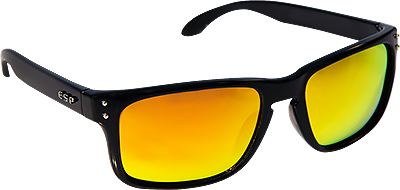Shades of play
Sunglasses are an essential component of anyone’s wardrobe. While sunshine is a welcome presence, it can pose a number of vision-related challenges.
From naturally occurring UV rays to the risk of dazzle and glare on wet surfaces, it’s always best to head out with a pair of sunglasses. That’s especially true if you already rely on a degree of vision correction from spectacles or contact lenses.
Recent manufacturing advances have made frames and lenses more stylish and versatile than ever. For instance, polarised lenses block out UV light as well as reducing any glare – a particular problem for water sports enthusiasts and cyclists. It might also be worth investing in anti-reflective coatings if you’re going to be spending a lot of time outdoors, making your vision clearer while reducing distractions. Photochromic lenses ensure a single pair of frames can provide clear vision indoors before darkening in sunny conditions, which is ideal if you regularly move between indoors and outside.
Durability is another factor worth considering. Scratch-resistant coatings will preserve the lifespan of your new sunglasses, giving crystal-clear vision for longer. Shatterproof lenses can withstand sudden impacts or pressure, while polycarbonate lenses are surprisingly lightweight, considering the level of impact resistance they provide. This makes them a great option for intensive activities like tennis or football.
Every pair of sunglasses in our practice provides comprehensive protection against harmful UVA and UVB rays in bright sunshine, reducing the risk of eye-related conditions like cataracts
However, it’s important to choose frames and lenses to suit your facial shape. If you’re going to be engaging in strenuous activities, look for wraparound frames which completely cover the eyes, eliminating any gaps between the frame arms and your forehead. A snug fit is also important for intensive activities like cricket or football, where badly-fitting frames might be knocked off your head if they’re hit by a flying object!
Children tend to spend large amounts of time outdoors, and they require even more protection against the sun’s rays than grown-ups. We stock a variety of children’s sunglasses frames, so the whole family can look good and stay safe, even under a cloudless sky.

Small wonder
Our eyes are a marvel of nature, and experts believe almost 50 per cent of the human brain is used for visual processing. Yet even though we’re born with fully-formed eyes, babies have to develop numerous sight-based skills in their first year. For example, newborn babies are colour-blind and can’t focus or recognise people’s faces.
However, these skills develop very quickly, thanks in part to the remarkably advanced condition of our eyes at birth. A newborn’s eyes are already two-thirds of their full adult size, and the process of learning to use these incredibly powerful tools begins immediately, in tandem with brain development. A six-month old baby is generally able to identify and track moving objects with ease.
Babies can see lights, shapes and high-contrast patterns from birth and are usually able to recognise their mother’s face within a few days. Eye coordination and focus improve rapidly in the first eight weeks
By this age, they should also be able to identify primary colours, with light sensitivity and depth perception improving all the time. With young children who can’t read letters, sometimes a picture test chart can be used to check their vision. Our eyes grow less than any other body part between birth and adulthood, so it’s important to make eye tests part of your child’s life from an early age. If you have any concerns about a child’s eyesight, it’s always best to get it checked.
Each eye is connected to our brain by over a million nerve fibres, which pass on the images reaching our retinas to our brains for processing
Picture perfect
Computer use is a central part of our lives, careers and hobbies. But how can we ensure a healthy relationship with those glowing screens?
Modern computer screens display crystal-clear pictures, making it even easier to use them for long periods. However, the human eye hasn’t evolved to suit this technology, so it’s important to minimise potential issues. Firstly, sit comfortably with your neck and back straight and your head level with the monitor. Avoid staring at the screen for long periods, which could cause headaches or fatigue. Take regular breaks, gazing into the distance to relax the eye muscles and blink regularly to moisturise the eyes. We blink less when we concentrate, especially while using a computer. Coupled with air conditioned offices, this can cause dryness problems. We can advise on lubricating drops to keep eyes comfortable and healthy.
Adjust screen brightness so it’s not dull or dazzling, and increase font sizes until they’re easy to read. Avoid reflections from direct sunlight or harsh spotlights, angling blinds and using diffuse full spectrum lamps. Clean the screen regularly to prevent dust causing eyestrain, while using a lint-free cloth and lens cleaning spray to keep spectacle lenses clean.
Your questions answered
In a regular column, we offer expert advice on common vision-related questions...
Q. What’s the difference between an optician and an optometrist?
A. Quite a lot! Although people tend to use the term ‘optician’ to describe everyone working in our practice, in the United Kingdom there are two distinct types of Registered Optician.
An Optometrist is in charge of examining your eyes, conducting sight tests and prescribing spectacles and contact lenses. It’s also an Optometrist’s job to detect any sight-related conditions or abnormalities.
The other type of Registered Optician is a Dispensing Optician. Dispensing Opticians, like Optometrists, are able to dispense and fit spectacles and other vision-correction products. Based on the Optometrist’s prescription, they will offer advice on lens and frame choices, tailored to suit your unique needs and preferences.
Dispensing Opticians and Optometrists are able to explain how to wear (and care for) your spectacles or contact lenses. Some Dispensing Opticians also have a specialist qualification in fitting contact lenses and are known as Contact Lens Opticians
Q. What’s being tested when I have an eye examination?
A. Regular eye tests are vital for monitoring your overall sight levels. We can determine what prescription you need to enjoy optimal vision, through a series of tests including asking you to read a letter chart. Having calculated your prescription strength, we’ll recommend suitable products.
A comprehensive eye examination allows us to compare current and historic test results, identifying trends or changes. As part of this process, we’ll examine each eye, ensuring healthy vision.
Q. I have worm-shaped objects gently floating in my field of vision. What are they?
A. It sounds like your eyes contain a number of floaters, also known as motes or spots. These strands of thick gel float through the thinner jelly which fills our eyes, blocking light and casting faint shadows onto the retina.
Floaters usually appear as black spots or translucent shapes, often resembling a segmented line or ring. Because they’re suspended within the eyeball, they slowly drift in whichever direction the eye moves.
Floaters are generally harmless, but a sudden increase in their numbers might indicate a developing condition like a detached or torn retina. This may also be indicated by the appearance of red spots or flashing lights, or even a large patch of darkness across your field of vision.
If you notice any changes in your floaters, any new flashes of light or any changes in your vision, our trained optometrists will be able to investigate your eye health and diagnose any conditions.


